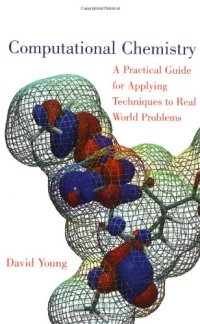
Ebook: Computational Chemistry: A Practical Guide for Applying Techniques to Real World Problems
Author: David Young
- Genre: Mathematics // Computational Mathematics
- Year: 2001
- Publisher: Wiley-Interscience
- Edition: 1
- Language: English
- pdf
This is a wonderful book for a novice in the field of quantum chemistry. It IS NOT a textbook of quantum chemistry, and is not intended to be.
It IS a book explaining in non-technical language, how to use existing programs and techniques to do calculations of specific types in a way that will practically guarantee that an answer to the problem can be calculated.
A useful feature of the book is that most chapters end with a checklist of techniques that can be used to calculate a particular property of interest (a transition state structure, for example), in the order of ease of use. By following this order, a novice will be almost guaranteed to finally calculate the property of interest.
Another exceptional feature of the book is a large table of calculational methods, and how accurate the results obtained might be expected to be (r.m.s. deviation from experimental values). This will particularly appeal to experimentalists, who are usually frustrated by the unwillingness of theoreticians to provide error bounds on computations.
Highly recommended for all beginning users of computational chemistry programs such as Gaussian, MolPro etc.
It IS a book explaining in non-technical language, how to use existing programs and techniques to do calculations of specific types in a way that will practically guarantee that an answer to the problem can be calculated.
A useful feature of the book is that most chapters end with a checklist of techniques that can be used to calculate a particular property of interest (a transition state structure, for example), in the order of ease of use. By following this order, a novice will be almost guaranteed to finally calculate the property of interest.
Another exceptional feature of the book is a large table of calculational methods, and how accurate the results obtained might be expected to be (r.m.s. deviation from experimental values). This will particularly appeal to experimentalists, who are usually frustrated by the unwillingness of theoreticians to provide error bounds on computations.
Highly recommended for all beginning users of computational chemistry programs such as Gaussian, MolPro etc.
Download the book Computational Chemistry: A Practical Guide for Applying Techniques to Real World Problems for free or read online
Continue reading on any device:

Last viewed books
Related books
{related-news}
Comments (0)